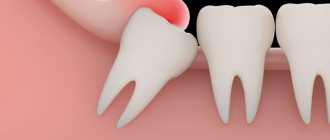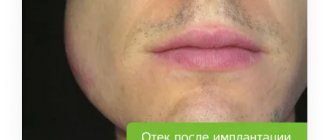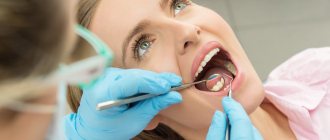- Physiological causes of gum swelling
- Pathological causes
- The gums are swollen and painful
- The gum is swollen and bleeding
- Flux with pus
- When you need to see a doctor urgently
- How to relieve pain
- How to treat swollen gums
- Rinse recipes
Bad teeth are not always the reason for going to the dentist; often patients come with gum pathologies. The reason for treatment is serious tissue damage with inflammation and suppuration. You should not try to treat them yourself - in order to avoid the development of disease due to gum tumors, you should consult a doctor as soon as possible to prescribe adequate therapy.
Causes of gum swelling
Physiological
Normal gums are pink, painless and of normal size. But sometimes they swell for natural reasons:
- during teething - in children and adults (wisdom teeth);
- after tooth extraction—slight swelling and redness of the gums is observed for up to 3 days;
- after injury - damage to the soft tissues of the gums leads to their swelling for some time while integrity is restored;
- during pregnancy - under the influence of hormones and due to the redistribution of blood in the body, gums may swell in women carrying a child;
- injury from dental structures - veneers, braces and fillings, if installed incorrectly, come into contact with gum tissue, causing damage to them.
There is no need to panic if the gums of a child aged 1 to 7 years are swollen. At this time, baby or permanent teeth erupt, which may cause swelling and redness in this area. Sometimes small balls appear - cysts. They are safe and in most cases go away on their own over time. If the cyst interferes with tooth eruption, it is surgically removed in dentistry in 1 session. The procedure is performed under anesthesia and does not cause any discomfort.
Pathological
In most cases, gum swelling occurs due to inflammation. Pathological reasons:
- periodontitis - local inflammation above or below the tooth;
- periodontitis - inflammation of periodontal tissues;
- gingivitis - inflammation of the gums;
- periodontal abscess - suppuration localized at the edge of the tooth;
- stomatitis - ulcers that appear on the soft tissues of the oral cavity;
- secondary infection against the background of immunodeficiency - with HIV or hepatitis, even opportunistic microorganisms can cause oral diseases;
- atypical sore throat - spreads to the gums, the main symptom is that it is painful for a person to swallow;
- Vitamin deficiency C - a lack of vitamin affects the gum tissues, causing them to swell.
Swelling of the gums due to an allergic reaction is also considered pathological. It can develop from an injection of an analgesic during dental treatment or from any irritant to which a person is sensitive.
Etiology: why gums swell
The vast majority of such reactions occur against the background of various inflammatory processes caused by pathogenic microorganisms. If the infection spreads to soft tissue, it is called odontogenic. But there are other options for the origin of the source of the disease.
Gums become swollen
due to the following factors:
- low level of oral hygiene;
- caries and its complications (including granulomas, cysts, periostitis);
- advanced stomatitis;
- hard dental deposits;
- diseases of ENT organs - otitis, tonsillitis, sinusitis and others;
- acute injury or tissue damage from an incorrectly made filling, crown, or prosthesis;
- difficult eruption of third molars (wisdom teeth);
- lack of vitamins (A, E, C, D);
- herpes virus;
- infection of the wound surface during dental operations.
Swelling can also be associated with allergic reactions, metabolic disorders, and reduced immunity, but sometimes it is temporary, and the dentist always warns patients about this.
This happens after anesthesia, as well as in the first 2-3 days after any interventions on the mucous membrane and periodontal tissues. For example, when gum plastic surgery was performed, removal of the overhanging gingival margin (for pericoronitis).
Non-inflammatory causes
If the gums are swollen not in one specific area, but diffusely, that is, evenly, this may be gingivitis of various etiologies. This disease also occurs in a hypertrophic form, when the volume of tissue increases greatly due to hormonal changes: during pregnancy, puberty, or various endocrinological disruptions.
It is important!
A sharp increase in gums requires mandatory and immediate consultation with a dentist. Even if you do not experience pain, bleeding or other discomfort, see a doctor.
Swelling of the gums with acute pain
When the gums are not only swollen, but also very painful, this may be a symptom of a serious pathology of the oral cavity. Most often, such complaints are accompanied by periodontitis. This is an inflammation of the soft tissues that support the tooth. Other symptoms of periodontitis include:
- increased body temperature;
- suppuration in the area of swelling;
- lack of temperature sensitivity of the tooth, as well as a reaction to sweets.
If swelling in the gums is accompanied by fever, it may be periodontitis. This is due to the fact that the factors in the development of pathology are most often related to infection.
Causes of periodontitis:
- transition of the inflammatory process from the throat or sinuses to the gums;
- penetration of microbes through the dental canal into the periodontium;
- advanced caries;
- poor-quality dental treatment, due to which irritating substances entered the periodontium;
- trauma to the periodontium or the tooth located next to it.
In rare cases, periodontitis develops as a consequence of an immunological reaction, that is, an allergy.
Why does pain occur in the lower jaw?
Purulent diseases
The cause of pain is inflammation of the bone, periosteum or nearby soft tissue. In 70-80% of cases the disease is of odontogenic origin. Less commonly, the process is provoked by acute infections and jaw injuries. Complemented by edema, hyperemia, general condition disorder, intoxication syndrome, regional lymphadenitis. Pain is observed in the following pathologies:
- Periostitis.
The symptom is more pronounced in acute purulent periostitis. The pain is sharp, pressing or boring, radiating to the eye, ear, temple, neck. Intensifies when opening the mouth. Weakness, low-grade fever, and swelling of the cheeks are noted. In chronic periostitis, the pain is periodic, moderate or mild, pressing or bursting. The contours of the face are slightly changed. - Osteomyelitis.
Characterized by a sudden manifestation with a rapid rise in temperature to febrile levels, chills, and severe intoxication. The pain is shooting, pulsating, diffuse, radiating to the neck and half of the face. They get worse when swallowing, limiting mouth opening. The teeth are mobile, pus is released from the gums. The oral mucosa and skin of the chin become numb. In chronic osteomyelitis, the symptom increases after closure of the fistula, decreases or disappears after the outflow of pus resumes. - Perimaxillary abscess.
The formation of an abscess is preceded by toothache. Then dense swelling occurs. The pain quickly intensifies, and the symptoms of intoxication increase. The patient refuses food. After spontaneous opening, the manifestations disappear; in the absence of treatment, chronicity with periodic exacerbations, resumption of pain and suppuration is more often observed. - Perimaxillary phlegmon.
Typically acute onset with rapid progression of local manifestations, purulent-resorptive fever. The pain is jerking, aggravated by talking, chewing, and moving the lower jaw, and is complemented by increased salivation and the formation of a diffuse infiltrate with a fluctuation zone. The condition continues to deteriorate due to severe intoxication.
Traumatic injuries
Injuries to the lower jaw most often result from fights. Damage due to falls, car accidents, or industrial accidents is possible. In case of a bruise, the asymmetry of the face is caused by swelling of the soft tissues; the closure of the teeth is normal. The symptom is moderate, quickly decreases, and does not create serious obstacles to articulation or food intake.
Among the fractures, injuries to the body predominate; violations of the integrity of the angle and branches are less common. Half of the fractures are bilateral. At the time of injury, a sharp explosive pain occurs, decreasing only slightly over time, intensifying when talking, biting, or chewing. Possible numbness of the chin and lower lip. Facial asymmetry, articulation disorders, stepped dentition, mobility, and sometimes tooth dislocations are noted.
Fractures of the alveolar process of the lower jaw are less common than the upper jaw; they develop from impacts, falls from a height, etc. They are accompanied by intense spontaneous pain, which intensifies when swallowing or attempting to close teeth. The mouth is half-open, and the protruding edge of a bone fragment can be seen under the mucosa. The bite is broken, the teeth are mobile, dislocations are possible.
Pain in the lower jaw
Neuralgia
The symptom is accompanied by trigeminal neuralgia involving the 3rd branch (n.mandibularis). It is provoked by external factors (shaving, cold air, water), stress on the masticatory muscles. Prosopalgia is paroxysmal in nature and is a series of pain impulses that are felt like a lumbago or electric shock from the side of the face along the lower jaw to the chin. The pain is sudden, lasts several minutes, reaches such intensity that the patient freezes, does not move, does not speak.
With neuralgia of the glossopharyngeal nerve, the pain impulse is caused by chewing, swallowing, talking, lasts from several seconds to 3 minutes, occurs at the root of the tongue, spreads through the tonsils, palate, pharynx, ear. Radiating pain in the lower jaw. In patients with ganglionitis of the submandibular node, the pain is paroxysmal, burning, boring, pulsating. Lasts from 1 minute to 1 hour. They begin in the tongue, spread to the lower jaw, temple, back of the head, neck, and shoulder girdle.
Muscle damage
Bruxism is formed due to spasm of the masticatory muscles. After night attacks, patients are bothered by pain in the jaws, caused by clenching and intense movements relative to each other. Muscle pain, dental pain, headaches, dizziness, and drowsiness are possible. With myofascial syndrome, pain develops due to overload of the masticatory muscles. It is perceived as moderately expressed and deep. At first it appears only under load (chewing, clenching the jaws), then it increases and becomes constant.
Dental reasons
The symptom is disturbing in the first days after tooth extraction. It is especially pronounced in the presence of an inflammatory process, removal of impacted or incorrectly erupted wisdom teeth. Some patients report pain due to wearing braces and dentures. Aching, pressing or pulling pain in the jaw and masticatory muscles, problems with chewing and swallowing, biting the cheeks and tongue are detected in children with malocclusion.
The cause of severe progressive paroxysmal pain, which spreads to the entire lower jaw and intensifies at night, is acute diffuse pulpitis. Prolonged intense pain under the influence of external stimuli, spontaneously occurring pain attacks are also observed during the period of exacerbation of chronic pulpitis. Irradiation along the trigeminal nerve is typical. Between attacks, moderate or minor aching pain is possible, aggravated by biting.
Tumors of the lower jaw
Pain syndrome is characteristic of a number of odontogenic and non-odontogenic benign neoplasms. Distinctive features of such neoplasias are slow growth and lack of germination of surrounding tissues:
- Odontogenic fibroma.
More often diagnosed in children. The pain is aching, not intense, and does not occur in all patients. It can be combined with tooth retention and inflammation in the affected area. - Cementoma.
As a rule, it is localized in the area of molars or premolars of the lower jaw. The course is asymptomatic or with minor pain that increases with palpation. - Osteoma.
Accompanied by pain, facial asymmetry, slowly increasing over months or years. Large tumors limit the mobility of the lower jaw. - Osteoid osteoma.
Unlike other neoplasms, the pain is sharp, intense, intensifying at night and when eating. The face is asymmetrical, in the oral cavity there is a bulge in the area of premolars or molars. - Osteoblastoclastoma.
More common in adolescence and young adulthood. Facial asymmetry, tooth mobility, aching, bursting pain gradually progress. Over time, fistulas form over the neoplasia. Pathological fractures are likely.
Malignant neoplasms of the lower jaw are found less frequently than benign ones. Cancer is characterized by a rapid increase in pain, radiating to the cheek, ear, eye, and temporal region. Accompanied by mobility, tooth loss, germination of masticatory muscles, salivary glands, and ulceration. Osteogenic sarcomas rapidly progress and quickly infiltrate soft tissues. Over the course of several months, the pain increases from moderate, pressing, aching or bursting to constant, unbearable, and can only be eliminated with narcotic analgesics.
Cardiac ischemia
Irradiation into the lower jaw can be observed with angina pectoris and myocardial infarction. Painful sensations are caused by the spread of impulses from the heart to the upper thoracic segments of the spinal cord, from there, along other nerves - to the face, neck, left arm, left shoulder blade. The main symptom is burning, pressing, squeezing or bursting pain behind the sternum.
An attack of angina lasts several minutes and is eliminated after stopping physical activity and taking nitroglycerin. During a heart attack, the pain is wave-like, very intense, lasts more than 30 minutes, and does not disappear when using the methods listed above. In the atypical course of a heart attack and coronary artery disease, retrosternal pain may be absent, only reflected pain is observed, including in the jaw.
If your gums bleed due to inflammation
Bleeding gums, associated with their swelling, is characteristic of periodontitis and gingivitis. In this case, the tooth does not hurt and does not cause discomfort. The difference between these diseases is that gingivitis occurs primarily. And if this condition is repeated more than once, it is already periodontitis - a pathology with a chronic course. Other symptoms of the disease include:
- bright red gum color with a bluish tint;
- pain at the site of swelling or throughout the jaw;
- swelling of the gums partially covers the tooth.
But the main distinguishing feature of periodontitis is bleeding gums. There are several reasons for this condition:
- diabetes mellitus in the stage of decompensation;
- the presence of systemic inflammatory pathologies;
- ARVI and acute respiratory infections;
- Tartar deposits;
- injuries of soft tissues of the oral cavity, occurring with complications;
- long-term treatment with glucocorticoids;
An x-ray is taken to confirm the diagnosis. It shows a noticeable reduction in the interdental septa, and less often, exposure of the tooth root.
When gums are inflamed and even your cheeks hurt
Sometimes the gums not only swell, but a new growth becomes noticeable on it. It is often pale in color due to the presence of pus inside. This is what a periodontal abscess looks like:
- the surface of the neoplasm is elastic and tense;
- swollen tissue around the abscess;
- the palate and cheek swell;
- sometimes the general body temperature rises, more often local;
- swollen tissues of bright red color;
- fluid movement is felt inside the abscess.
This disease is often called "flux". It has a rather characteristic picture. An abscess develops due to lack of treatment for periodontitis: suppuration appears that cannot come out. “Flux” is accompanied by very severe pain and swelling.
Treatment of an abscess is carried out only surgically and in a hospital setting. Attempts to cure flux at home with lotions or self-opening can result in phlegmon, sepsis and, in rare cases, even death. In the best case scenario, the patient will receive major surgery with pus removed through large incisions in the face instead of a small hole in the gum. Therefore, you should not delay visiting the dentist.
Why do gums swell?
Have you noticed that your gums are swollen and red? Do you experience unpleasant sensations or discomfort when chewing food? There may be several factors and it is best to consult a doctor. The beauty, health and even safety of teeth depends on the correct and accurate diagnosis at the first symptoms of gum swelling.
Method of conservative treatment of gums using the “Vector” system
Dentists at the Zdorovye clinic identify several causes of gum swelling. This could be a trivial minor injury to the oral cavity: for example, when using a toothpick carelessly or chewing a bony fish too vigorously. Even the crust of bread can be the culprit of a microscopic scratch. If an infection gets into the wound, the gums become inflamed and swollen. As a rule, this does not lead to dire consequences, but the patient cannot always assess the cause and stage of inflammation. Unlike a doctor, who with a trained eye will determine the source of discomfort and the best solution to the problem.
Another common example of mechanical damage is gum burn. It can be chemical (using aggressive liquids) or thermal (hot tea). The gums swell, change color, and sharp, painful sensations appear. As a rule, redness in such cases goes away within a day, and a white film appears in its place. Swelling of the gums may last a little longer. At this moment, it is important to quickly and competently heal the wound on the mucous membrane, preventing the development of serious complications that can damage the tooth.
Finally, the third and most serious cause of gum swelling is true inflammation of the oral cavity due to gingivitis or periodontitis. In this case, the swelling is accompanied by severe bleeding of the gums and its redness. This is a secondary sign of a problem that requires immediate attention to the dentist. With the development of severe stages of periodontitis, the infection can spread to adjacent teeth and bone, leading to tooth loss. To prevent this, periodontists at the Zdorovye clinic select individual treatment in each case. At the first signs of gum swelling, it is very important to correctly determine the root cause of the problem. For an accurate diagnosis, the patient is given an x-ray, based on which the dentist assesses the severity of the inflammation. At an advanced stage, surgical intervention may be necessary - curettage of periodontal pockets or flap surgery. But, as a rule, doctors try to limit themselves to therapeutic methods: removing soft plaque and tartar, selecting anti-inflammatory drugs, applications to the gums and medicated toothpastes.
Reason to see a doctor
If you were able to independently determine the cause of the gum swelling (an erupting tooth is visible, an injury is obvious, a tooth was recently removed, etc.) and it does not require the intervention of a doctor, you do not need to go to the clinic. But if the inflamed gum hurts for more than 3 days and there is no improvement in the condition, you should still consult a doctor.
If you have gum inflammation, you need to urgently go to the hospital in several cases:
- there was an unpleasant odor from the mouth and pus was found;
- not only the gums are swollen, but also the cheek;
- when you tilt your head to the painful side, you feel heaviness;
- there is a high temperature;
- swollen tissues are very different in color from healthy ones (white and yellow tumors indicate suppuration, and bluish and burgundy shades indicate blood stagnation);
- the pain seems to pulsate and is not relieved by analgesics.
Even in the absence of these symptoms, but if the cause of gum swelling is unknown, it is worth visiting a specialist. This will help avoid dangerous complications, as well as quickly alleviate the condition, relieve or reduce pain.
Saying goodbye to gum pain
If your gums are sore and swollen, what should you do first? No, don’t use a plot from your mother’s best friend’s neighbor’s great-grandmother. All “spells” for dental problems are in the hands of the dentist, and only he knows how to correctly “spell” gums from pain and bleeding.
Inflammatory processes occurring in the teeth and gums in the case of periodontitis and gingivitis are provoked, as already mentioned, by bacteria colonizing tartar. So, if you notice that your gums are swollen, what should you do with your right mind? That's right - remove stone deposits from teeth. Unfortunately, no toothbrush can “overpower” tartar plaque, so you need to go to the clinic for professional teeth cleaning. Only when the teeth are cleared of all deposits will therapeutic treatment be prescribed, including antibiotics, if the complexity of the case requires it.
Don’t ask about advanced inflammation: this is only a matter for the dentist. You can treat inflammation yourself only in the initial stages; it includes rinsing the teeth with a chlorhexidine solution and treating with cholisal gel.
The course is usually designed for 10 days. Procedures must be carried out after meals in the morning and evening. Such rinses are quite effective when the case is not advanced.
If your gums hurt not because of mild inflammation, but because of the development of severe and moderate periodontitis, then the treatment process will be different.
Periodontitis is the development of an inflammatory process at the apex of the tooth root, which leads to a periodontal abscess - the formation of a dental cyst - a sac of pus that can burst and leave a fistula opening. Under such circumstances, pain in the gums can be caused by caries or pulpitis. How to treat gums with periodontitis? Treatment in this case will consist of:
- removal of carious areas of dental tissue;
- nerve removal;
- treatment of root canals with medicinal paste and temporary filling;
- removal of stones;
- anti-inflammatory therapy of a general or local nature.
First aid for swollen gums
Under no circumstances should a heating pad be applied to an inflamed gum! This is dangerous due to the rapid spread of infection and the development of complications.
To “live until the morning” when you can go to the doctor, you can take several actions that can alleviate the condition:
- apply cold to the sore side - this will constrict the blood vessels and temporarily relieve the fever;
- take an analgesic - but only while you sleep at night; in the morning you need to come to the doctor without pain relief, so as not to erase the picture of the disease;
- drink an antipyretic - if a high temperature prevents you from falling asleep, you can bring it down, but don’t forget to mention it in the morning at the doctor’s office;
- rinse your mouth with an antiseptic - this will slightly slow down the spread of inflammation;
- use a spray with lidocaine on the painful area - this will temporarily relieve the pain.
All of the above measures can only be used as temporary measures. Only a doctor can prescribe adequate treatment after an in-person examination.
How to treat swollen gums
Treatment of inflamed gums begins with identifying the cause of the disease. To do this, an X-ray of the jaw and an examination of the oral cavity are performed.
Further tactics depend on the established diagnosis. If surgical intervention is necessary (opening an abscess, removing a cyst), it is performed immediately. The patient is anesthetized in the dentist's chair, and then all necessary manipulations are performed.
After surgical treatment, maintenance drug therapy is prescribed. It allows you to avoid the development of complications. Most often, the patient is prescribed rinsing with an antiseptic solution and taking anti-inflammatory drugs. Antibiotics are sometimes recommended to prevent bacterial complications. They should be taken only as prescribed by a doctor, and exactly the drug that is indicated in the prescription. This is important to achieve a guaranteed positive effect.
Some drugs do not combine with each other. Therefore, uncontrolled use of medications can harm the patient himself. If you choose the wrong antibiotic, the bacteria will not only not die, but will also develop resistance to the drug. Then it will take a long time to select a suitable remedy, which will complicate the patient’s life - it will no longer be possible to quickly get rid of unpleasant symptoms.
Rinse recipes
The patient's attending physician should prescribe rinses. They are not allowed for all diseases. After surgical treatment, rinsing too hard can cause the suture to come apart. An infection or food particles will get into an open wound, which will cause new inflammation and suppuration.
It is impossible to completely cure swollen gums with rinses. But they are advised to be combined with drug treatments to alleviate the condition and enhance the effect of the drugs.
- Decoctions of medicinal herbs: chamomile, calendula, lemon balm, sage, St. John's wort. Some components can cause allergies, so you need to be careful with them. However, they have a mild anti-inflammatory effect and can help relieve swelling and reduce inflammation.
- Propolis tincture - dilute it with warm water and rinse your mouth 2 times a day. The product helps against ENT diseases (sore throat and sinusitis), which often develop into inflammation of the gums.
- Soda and salt - add 1 teaspoon of each powder to a glass of warm water and stir. The product has a wound healing effect and helps stop bleeding gums.
In addition to rinsing, lubricating the area of inflammation with tea tree or fir oil is also effective. They have an anti-inflammatory and wound-healing effect. However, they should not be applied to the site of suppuration. It is also worth considering the risk of plant allergies.
There are many reasons for gum swelling, not all of them are obvious. Only a doctor after diagnosis can figure out what caused the inflammation. Independent attempts to cure the disease often lead to serious complications, so you should not expect that the swelling on the gums will go away on its own. It is better to visit a doctor and make sure there are no risks or get competent and timely treatment.










